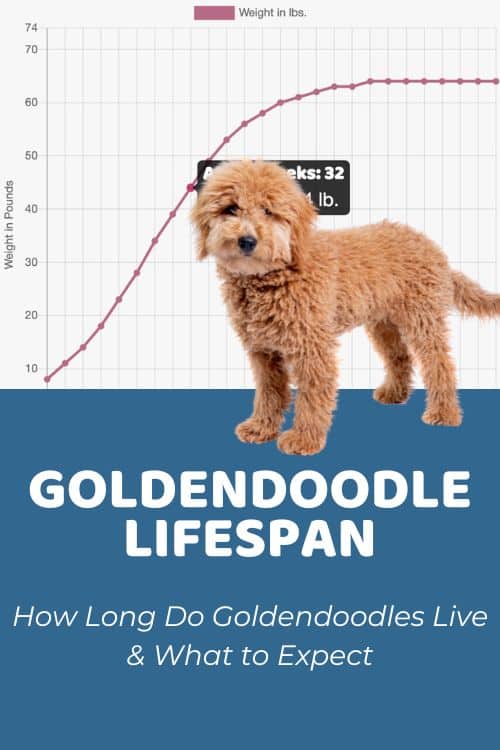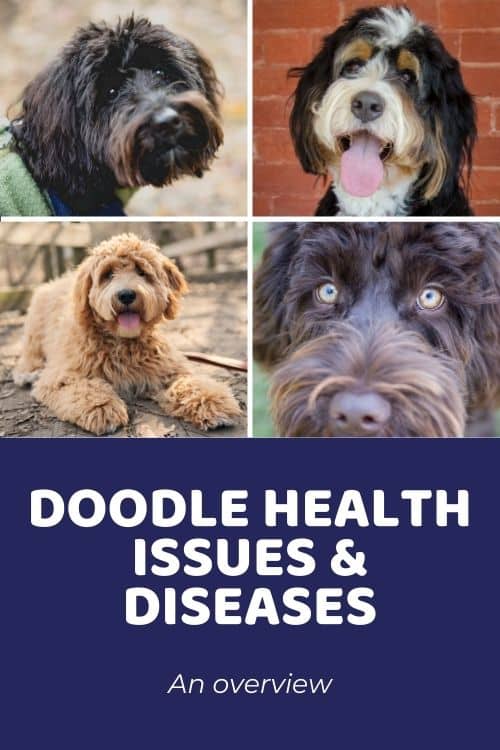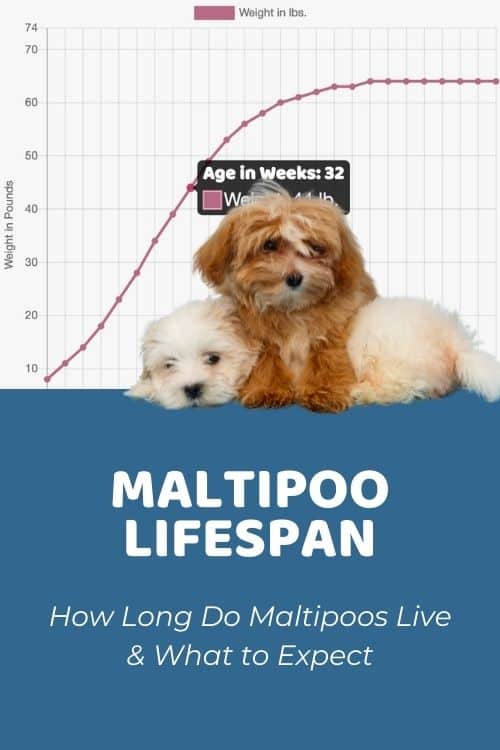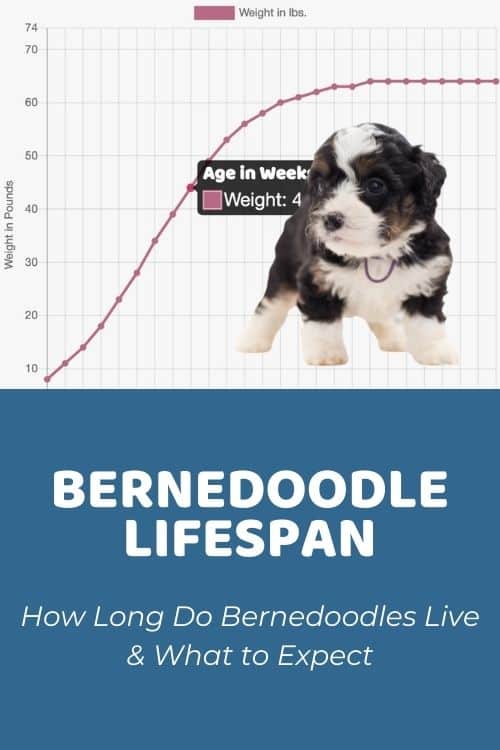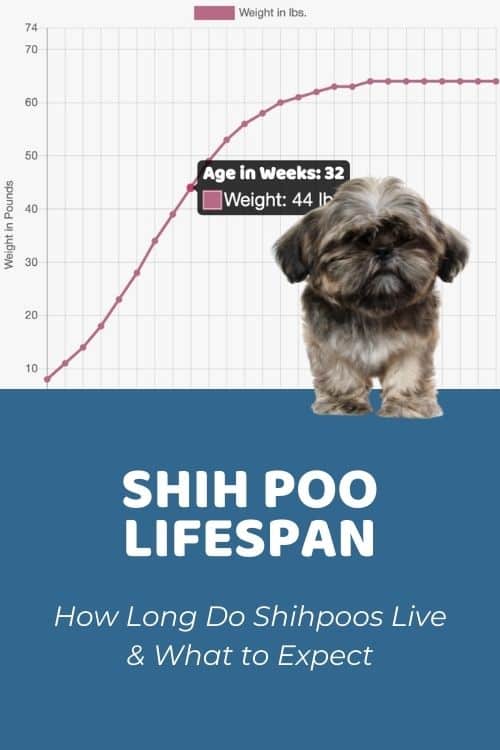With their perfect family-dog natures, Goldendoodles are highly prized pets indeed. However, if you are thinking of adopting one, you may be concerned about the kinds of health issues these dogs might develop and the general Goldendoodle lifespan – how long they are likely to live overall. After all, everyone wants a happy, healthy hound with which they can enjoy many long years of fun, games, love, and companionship, right?
Choosing the right breeder, getting your pup neutered, and providing them with the best kind of nutrition and plenty of exercise are all very real things you can do to ensure your Goldendoodle stands the best chance of a long and healthy life. Keep reading for more on this, as well as details on your dog’s different life stages, which conditions are more common to the breed, and how to spot the signs that your pup may be getting on a bit.
Table of Contents
- Goldendoodle Lifespan
- Life Stages of a Goldendoodle
- Common Goldendoodle Health Problems
- Extending the Lifespan of a Goldendoodle
- Frequently Asked Questions About Goldendoodle Lifespan
- Goldendoodle Life Expectancy: Conclusion
Goldendoodle Lifespan
Goldendoodles tend to be pretty vivacious pups with very few health concerns. One of the key reasons for this is their more varied genetic makeup which places them at a lower risk of inheriting the kind of diseases that plague pedigree lines. For this reason, you might expect them to hang around for somewhere in the region of 10 to 15 years. Although, where exactly your pet will sit in this admittedly broad average is dependent upon exactly what kind of Doodle they are.
Goldendoodles come in a wide range of sizes, colors, and generations, meaning that every single one is truly unique both in their looks and their personality. Certain of these variations can account for differences in their lifespan, as well. The most significant of these is size, followed by generation. Let’s take a look at exactly what this means for your dog:
Individual Differences: Size
Currently, there are three distinct sizes of Goldendoodle: Standard, Mini or Medium, and Toy, based upon the size of the Poodle(s) used in the breeding. These dogs differ quite significantly both in height and weight.
- The Standard Goldie is the biggest at 50 to 90 pounds and 20 to 26 inches to the shoulder. They are classified as large-sized dogs.
- The Mini or Medium Goldie sits in between at 25 to 50 pounds and 15 to 20 inches to the shoulder. They are classified as medium-sized dogs.
- The Toy Goldie is the smallest at 10 to 25 pounds and less than 15 inches to the shoulder. They are classified as small-sized dogs.
As you might already know, smaller dogs typically do better in terms of longevity than their larger counterparts. This means that Toy and smaller-sized Mini/Medium Goldies usually outlast Standard and larger-sized Mini/Medium ones. They will be towards the higher end of the average at 12 to 15 years rather than the lower end at 10 to 12 years.
Individual Differences: Generation
There are also at least seven possible variations of these dogs in terms of generation. This refers to whether the parent pups are purebreds, Goldendoodles, or some mixture of the two. The generation of the dog tells you what amount of each parent breed’s genes are likely to be present in the mix, e.g., 50% Poodle, 50% Golden Retriever (F1) vs. 87.5% Poodle, 12.5% Golden Retriever (F1BB).
Poodles tend to have a slightly longer lifespan than Golden Retrievers (12-15 years compared with 10 – 12), so pups with more of their genes likely have the advantage here. This goes doubly so for smaller Goldies, who not only benefit from their size but also tend to be multigenerational, which is the easiest way to breed small dogs from larger parents like the Golden Retriever.
Life Stages of a Goldendoodle
While the stages of a Goldendoodle’s life follow the same predictable pattern as almost every other dog out there, their size will, to some degree, determine how quickly they move through these different life stages.
Puppyhood
There are two distinct parts to a dog’s puppyhood:
- The first is where they are considered still an absolute puppy and are growing into their adult height. This lasts from the day they are born right up to when they reach sexual maturity. The age at which this happens is typically between 6 and 9 months. Smaller dogs naturally reach both their adult size and sexual maturity much earlier than larger ones.
- The second is adolescence, when they are still growing into their final weight and still have all the boisterous energy of a puppy. Again, bigger dogs will take longer to get past this stage. They will do so at somewhere between 12 and 16 months compared to a littler dog’s 7 to 11 months.
Health Considerations
You will need to be thinking about vaccinations, deworming, and flea/tick control measures during your pup’s earliest years. It’s also a good idea to get them checked out by the vet within the first few days of picking them up. In fact, this is often a requirement of the purchasing contract. This way, you can be sure that you are adopting a perfectly healthy animal.
Teething will be an issue at this time. You’ll notice that your pet is much more liable to chewing behaviors now. You might also see excessive drooling, swollen, red, bleeding gums, a decreased appetite, and tummy issues. You might want to invest in chew toys to allow your pup to alleviate their painful gums on something other than your fingers or furniture during this uncomfortable time.
However, by far the biggest risk to your dog in their puppyhood is injury. This could result from the dog’s own actions, e.g., escaping from their leash or the yard, or someone else’s, e.g., being accidentally dropped or stepped on (this is a big problem, especially for more miniature Goldies). Alongside careful training and socialization, make sure you take time to teach your kids the right way to behave around their new family member.
Adulthood
Likewise, there are various stages of adulthood, each with different things to think about:
- Your pup will enter young adulthood between 7 and 16 months (depending on their size). At this time, they will be at their full size and will have their adult coat. They will also seem, for the most part, much calmer and in control of their behavior.
- At around 3 years of age, regular adulthood begins. Those early years spent on training and socialization will really be apparent at this stage. Keep focused on providing your pup with the proper nutrition and regular exercise to keep them healthy.
- The senior years will begin much earlier for larger dogs, at around 8 years of age. Smaller dogs might show signs of slowing down from about 10 to 12 years of age. While you will need to keep a closer eye on your pal’s health at this time, they likely have a good few years left in them just yet.
Health Considerations
As your pet is much more likely to know what they are about in their adult years, the risk of injury does decline somewhat. So there isn’t too much to worry about during their young adulthood and the first part of their regular adulthood. Just make sure to keep them in good condition and maintain that tricky coat of theirs. You’ll also need to keep their ears clean, nails clipped, and watch out for signs of fleas and ticks.
Towards the later stages of adulthood, however, you might begin to notice that your pup becomes a little lazier, a little less willing to walk too far or too fast, and a little more inclined towards sleep. They may also be toileting more frequently and show signs of joint stiffness, particularly after long periods of lying down. These are all perfectly normal signs of aging and shouldn’t worry you too much.
However, it is important to be on the lookout, at this time, for other signs of pain and stress that could signal the presence of a degenerative disorder. By now, you’ll be very familiar with your dog and all their moods and little idiosyncrasies, so this shouldn’t be too tough. If anything about your pup’s movements or behavior worries you, you shouldn’t hesitate to get them to the vet.
Common Goldendoodle Health Problems
One of the most significant benefits of the increased popularity of Doodles is that there are by far more responsible breeders of these dogs than ever before. This is great news because these facilities go to great lengths to ensure the genetic health of their puppies. Breeding dogs are put through a barrage of tests that calculate their likelihood of passing on hereditary issues to their offspring. In fact, most breeders these days are so confident in the health of their dogs that they are willing to put up a money-back guarantee.
If you’re on the lookout for a top-quality breeding facility near you, check out our Goldendoodle breeder directory broken down by state.
However, not all conditions Goldendoodles are susceptible to can be tested for, and not all are inherited. While it is undoubtedly true that these dogs benefit from fewer breed-specific issues than their parent pups. There are still a few health problems that could rear their ugly head. These include:
- Hip and elbow dysplasia – a condition where the thigh bone becomes displaced from the hip joint. These are more common in larger dogs, particularly if they are overweight, but smaller breeds are still at risk.
- Subvalvular aortic stenosis – a congenital cardiac disease where there is a narrowing of one of the main valves of the heart. Again these are more often seen in larger breeds and comes from the Golden Retriever side.
- Sebaceous adenitis – an inflammatory skin condition that primarily affects young adult dogs. Signs of this include hair loss and scaling. Goldies can inherit this from their Poodle side.
- Addison’s Disease – a hormone issue caused by failure of the adrenal glands. Addison’s Disease can affect any dog, but Standard Poodles are particularly predisposed to it.
- Cataracts – one of the most common causes of sight loss in dogs. The eye lens becomes cloudy, preventing light from passing through into the eye. These are most often seen in aging dogs.
Aside from these, all Doodles are prone to allergies and sensitivities, mostly from their Poodle side. When it comes to food, chicken is a common culprit for everything from stomach troubles to dry, itchy, flaky skin and a dull and lifeless coat with these dogs. So if you are noticing such symptoms, it might be a good idea to switch to a chicken-free food formula.
Goldendoodles are also more susceptible to cancer on their Golden Retriever side. This is definitely something to be on the lookout for as another great reason for those regular vet checks.
For more on this topic, take a look at our dedicated article: Common Doodle Health Issues.
Extending the Lifespan of a Goldendoodle
While all this may have you worrying about all the various things that could go wrong for your Goldie, rest at ease. The chances of your pet going on to develop any of these are quite small. You can also further reduce the risk with the following:
Feed them a suitable diet for their life stage
Probably the very best thing you can do for your pet is to feed them a diet rich in the kind of nutrients that help them keep healthy. Dry kibbles tend to be the best choice as they contain so much more than just meat – healthy fats, carbs, vitamins, and minerals. Like us, canines require a careful mix of all these and more. However, the specific amounts of these vary very much depending on your dog’s size as well as their particular life stage.
The more popular dog food brands have developed formulas for large, medium, small, and toy breeds as well as for puppies, adults, and seniors. These contain varying amounts of protein, fat, calcium, and more. You need to opt for the right one for your dog to properly support their health throughout their lives. Alongside this, you must make sure that you are feeding your pup the correct amount based on their weight. Obesity in dogs is a common issue and one that makes them far more susceptible to a range of health problems.
Make sure they get plenty of exercise
The other side of this is altering your pooch’s walks, games, and outdoor time to their exact needs. Age obviously plays an important role here. While you want to keep your older dog as active as possible, you don’t want to put their bones and joints under too much unnecessary strain. The same goes for younger pups. Too much stress on their bones can negatively impact their development. Frequent shorter walks really are best for these guys and gals. Once they reach their full size, you can start lengthening these to suit your lifestyle.
Once again, size also plays a role here. With its two supremely athletic parents, the Standard Goldendoodle naturally has higher exercise needs than pups with Miniature or Toy Poodle ones, so you need to be fully prepared for this. These dogs also need frequent access to outdoor space, so if you don’t have a backyard, then you need to get ready for frequent trips to the park throughout the day. While smaller dogs may not be quite as demanding, it’s still crucial that they get out at least twice a day for around 30 minutes each time.
Keep them safe at all times
It goes without saying that you will your pet’s best interests in mind. You will want to protect them from harm in every way you can. Training them to respond to specific commands such as ‘come’ and ‘leave it’ can help keep them close or encourage them to not eat trash and leftovers from the street. Goldies are very receptive to learning, so training them should be relatively straightforward, especially if you are already familiar with the process.
However, no matter how well trained your pup is, always expect the unexpected. That’s why it’s best to keep your dog leashed when walking on the street or in a park area that isn’t secure and is close to the road. Excitement can easily override training in certain circumstances, such as when another dog or animal is present. You should also regularly check the boundaries of your yard to ensure your pal hasn’t managed to create any holes in the fence or dig under them.
Quickly take care of any health problems
Keeping your dog up to date on any vaccinations, pest prevention treatments, and deworming will stand them in good stead for remaining in the best of health. As will regularly consulting with your vet on any changes in your pup’s appearance or behavior throughout their lives. Either of these could signal the presence of some underlying disorder. The quicker you get these diagnosed, the more successful the treatment will be.
Vet visits should be more frequent at the start of your pup’s life as well as towards the end. If you choose to breed your Doodle, you’ll always want them to be carefully monitored throughout the process. Your vet is also a good place to turn if you have questions on supplements, maintenance, or anything else canine. They will be able to make recommendations, which will be much more specific if they see your pet regularly and get to know them well.
Brush, wash, and trim them regularly
Another vital part of pet ownership is caring carefully for your fur baby’s coat. Goldendoodles can inherit the Poodle’s curly single-layered coat, the Golden Retriever’s straight or wavy double-layered coat, or one that sits somewhere between these two extremes. Whichever they get, you will need to ensure frequent brushing to prevent them from having issues with knots, tangles, pests, and more. These, in our opinion, are the very best brushes for Goldendoodles that will make this process easier.
You’ll also need to regularly bathe your dog to keep them clean and fragrant and support the health of their skin as well as their hair. Opt for a top-quality shampoo but make sure it is designed especially for dogs. Human shampoo can dry a dog’s skin out. With two long-haired pups in the Goldie mix, you’ll also need to schedule your pal in for regular trims if you don’t decide to take care of them at home. Here are some of the top Doodle haircuts you can choose from.
Frequently Asked Questions About Goldendoodle Lifespan
What is the average life span of a Goldendoodle?
Depending on the size of your pup, you can expect somewhere between 10 to 15 happy years with them. If your Goldie is a Toy or Mini/Medium variety, they will be on the higher end of this average, as smaller dogs tend to outlive larger ones. Pups with more Poodle genes are also said to live longer, although the difference is less significant.
What health issues do Goldendoodles have?
Goldendoodles can suffer from the same health conditions as the two parent breeds that go into their creation. Their Poodle side makes them more susceptible to allergies, sensitivities, and ear and eye issues. The Golden Retriever side can put them at more considerable risk of certain types of cancers. Although, overall, they are less at risk than pedigree dogs.
Are Goldendoodles generally healthy?
Goldendoodles, as well-bred, hybrid hounds, are usually very healthy dogs. Not only do they benefit from a larger, more varied gene pool (based on them being crossbreeds rather than purebred pups), but their popularity means that they are being ever more careful bred to avoid genetic issues being passed down through breeding lines.
Goldendoodle Life Expectancy: Conclusion
Being able to care for and nurture a loving pet is a beautiful thing. Yet, however well you care for them, death is, unfortunately, an inevitable part of life. As distressing as it might be thinking about a cherished pet no longer being with you, it is necessary to consider this before you decide to adopt. Doing this will make you more aware of the diseases and conditions that could impact your pet, making it more likely that you will spot any early signs so they can receive the best treatment. In this way, your Goldendoodle can enjoy the very best time with you and your family for the duration of their, hopefully, long and healthy lifespan.
Learn How to Care for Your Doodle Puppy!

Perfect for first-time Doodle parents, get ALL your questions answered, including questions new Doodle parents don’t even think to ask.
Plus, get $700 worth of Bonus Materials for FREE, including:- Doodle Parenthood Community and Support Group ($190 value)
- Doodle Puppy Growth Tracker ($20 value)
- EMERGENCY Cheatsheet: When To Call The Vet Immediately ($50 value)
- HELP! Button ($145 value)
- And SO MUCH MORE!
The information on this page is for informational purposes only. It is not intended to be a substitute for qualified professional veterinary advice, diagnosis, or treatment. Always seek the advice of your veterinarian or other qualified animal health provider with any questions you may have.

